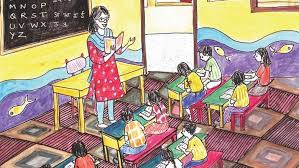The Human Resource Development (HRD) ministry in October 2015, then under Smriti Irani, constituted the T.S.R. Subramanian Committee to suggest recommendations for the National Education Policy. The committee submitted its report in May 2016 and the ministry held several consultations with various stakeholders on the report’s contents.
In 2017, Prakash Javadekar took over as the HRD minister. He rejected the Subramanian panel’s report, disbanded the committee and constituted another committee under the former Indian Space Research Organisation (ISRO) chief K. Kasturirangan. The committee started working on it in July 2017. The Kasturirangan panel was to initially submit its report in December 2017. Since then, there have been innumerable extensions. It seems that the Government will probably not release the report before elections.
The current education policy is more than 30 years old, which is why the government promised to review it and bring in reforms. The challenge is to junk the old school thinking and embrace reforms. However, it will not be easy to undo how education has been perceived and provided in India for a long time. Here is a quick look at what a policy overhaul could consider.
What kind of a good/ service is K-12 Education?
Education is NOT a public good. Education is a rivalrous good – a student’s admission in a school may diminish the chance for others; too many students in a class may imply low-quality engagement. Similarly, education is not inexcludable – it is possible to exclude students from availing education. Education is not like national defence or air – one person’s consumption does not exclude others. Hence, it is not a public good.
Some people call it public good because it produces immense positive externalities to others. What they imply is education is a “merit good” – it should be universally available irrespective of affordability. That makes a case for public funding of education at best – not necessarily for public provisioning of education.
What should the policy address?
The government may have data for identification of problems in K-12 education. The data may indicate the contemporary issues in K-12 education such as low enrolment, dropouts or poor quality. Before rolling out the measures to address such problems, the policymakers must first identify the root causes of these symptomatic problems. Are these problems the consequences of market and government failure or something else?
For example, poor learning outcome may be a case of accountability deficit, lack of motivation for teachers or some other phenomenon. Another example is low enrolment – no faith in the education being provided, the value of child labour over education et al.
Unless the root cause is correctly identified, no policy measure can be correctly prescribed.
India does not have freely operating markets in K-12 education. There are a number of entry barriers, operational barriers as well as restrictions on earning profits. Such a regulatory framework chokes the market and produces sub-optimal results. On the one hand, it discourages low-fee education providers and on the other hand, it would lead to an oligopoly of big quality schools who would then demand quite a high fee.
The solution would be to not have further controls – rather the policy should foster more and more competition and innovation.
Whom should the policy address?
The policy should be designed for the child, the learner. She should be respected as she is – with all her talents and weaknesses.
A government school with zero students and five teachers on payroll cannot be justified on grounds of teacher employment. A school exists primarily for imparting learning to students, not for guaranteeing employment to teachers.
Secondly, what the child needs, the parent knows the best. Parent’s right over the child supersedes all other interests – societal, state and community. The state can, at best, make all the information available to the parents.
For example, a state government may be tempted to impose the official language of the state as the compulsory medium of instruction. But parents may prefer English as the medium of instruction. In this context, expert advice, even if it sides with the state government and favours mother tongue, is irrelevant. The parental choice must be respected.
What tools should the policy adopt for attaining objectives?
First, the policy must do away with all licensing and permit raj for education providers. Instead, it should have a registration system. If a parent finds the education services deficient, she should hold the school legally liable for the deficiency. At best, the state can facilitate a certification system for the schools based on pre-announced parameters. Such ratings can be done and maintained privately or like Zomato, Google and Practo currently practice in their respective sectors.
Secondly, the policy must focus on outputs or learning outcomes and not inputs. It means that the size of the school building is not as relevant as school results.
Third, not only there is any compelling reason for the State not to establish and run schools, doing so would create a conflict of interest between its regulatory and provisioning role. Public funding can be done through direct benefit transfers or vouchers.
Fourth, there must be no policy intervention if not supported by evidence. In absence of any evidence, the presumption should be in favour of market forces and parental autonomy rather than state control.
Fifth, as far as possible, the lowest tier of governance/regulator should make the decision if it must. For example, instead of the central government, it should be the state government, District or Block Education Officer, Gram Sabha/Panchayat or Resident Welfare Associations. Government schools could be handed over to the local community with the power to hire & fire the staff and handle finances independently.
Why is it a political challenge?
The current policy creates rent-seeking opportunities for several stakeholders, particularly government school teachers. Teacher unions strongly lobby for safeguarding their interests. Teachers, especially in government schools, earn a high salary without much accountability.
It is unlikely that any government would like to upset its electoral support system right before parliamentary elections, peculiarly when they are well aware that government school teachers are involved in election duties at the polling booths.
Read more: https://spontaneousorder.in/nep-paradigm/
Post Disclaimer
The opinions expressed in this essay are those of the authors. They do not purport to reflect the opinions or views of CCS.






